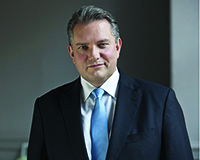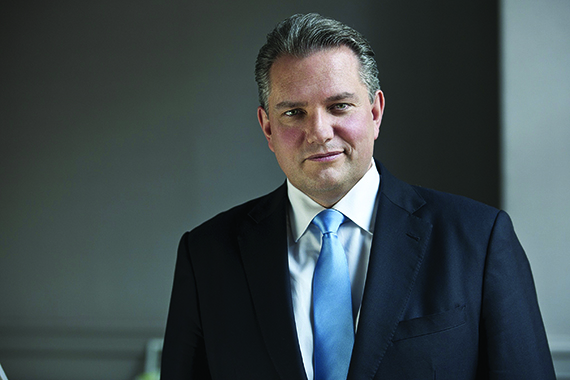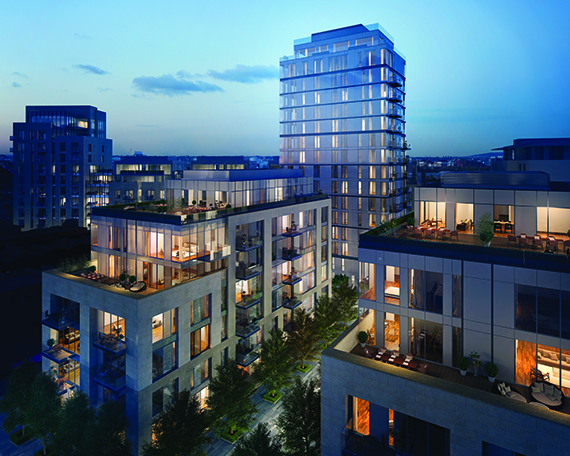The last gig at Earls Court took place a fortnight before Christmas. Playing to a 20,000-strong crowd, indie rock favourites Bombay Bicycle Club grasped the sense of occasion. The band recruited Elbow’s Guy Garvey for a spoof film played before their arrival on stage. “To say ‘religious experience’ would understate it,” said Garvey from, supposedly, the year 2039. It was a nice touch, contrasting the band’s hoped-for longevity with the venue’s imminent demise.
Within days of the curtain coming down, preparation for deconstruction began. Removal of a bridge over the railway tracks completed ahead of schedule and on Monday, control of the whole site was handed over to demolition contractor Keltbray. The main works onsite begin in February.
 But symbolic though it is, there is much more to the £1.1bn regeneration of the Earls Court area than the closure of a venue (right) that has played host to countless concerts, the volleyball competition at London 2012 and much else besides.
But symbolic though it is, there is much more to the £1.1bn regeneration of the Earls Court area than the closure of a venue (right) that has played host to countless concerts, the volleyball competition at London 2012 and much else besides.
Under the Terry Farrell masterplan, developer Capital & Counties will deliver four urban villages, a high street and 7,500 homes as well as new work spaces and offices expected to generate up to 10,000 new jobs. Construction will take two decades.
It all adds up to a “re-imagination” of the area, to borrow CapCo’s phrase, “into a world-class residential district where Kensington, Chelsea and Fulham meet”. In doing so the firm hopes to repeat the stunning success of Covent Garden, its other major asset, which under its ownership has become one of the most coveted pieces of real estate on the planet.
But while Covent Garden is all glamour and glitz these days – indeed, CapCo began 2015 by announcing it was to redevelop the former home of luxury spa The Sanctuary on Floral Street into a mixed-use scheme – Earls Court is a grittier prospect. It’s a project in a less celebrated part of London where challenges are coming thick and fast.
Re-imaginer in chief is CapCo chief executive Ian Hawksworth, who cut his teeth in Asia and is bringing that experience to bear in the capital. And while focusing on the future, he is unafraid to draw on the past.
“I like history and the history of companies,” says Hawksworth. “If you think that Covent Garden was actually the first planned luxury residential development in London, built by the Earl of Bedford in the 1600s, the symmetry of us having Earls Court, which is probably one of the last large-scale developments in central London, is interesting.
“And if you look back at what CapCo set out to do in the 1930s and post-war, it was there to own residential and retail. It’s nice to see the business going back to its roots.”
But just when it sounds like CapCo’s present strengths owe much to historic luck, Hawksworth adds: “CapCo is in a fortunate position today, but it’s not by accident. The strategy was to focus on large-scale nodal-point investments in central London. When we bought Earls Court, I don’t think many people thought we’d done a particularly interesting thing. It was deeply unfashionable at that point.”
Opposition lines up
As with any large-scale development, there has been opposition to the project; given its scale, perhaps there has been more than most. It reached a crescendo at MIPIM UK at Olympia last October, with many protestors conflating the redevelopment of the area with anti-Boris sentiment and an anti-developer agenda.
But perhaps the least-anticipated challenge came last May when the supportive Conservative-controlled Hammersmith & Fulham council switched to Labour.
“I think everybody was surprised,” says Hawksworth, “not least Hammersmith council. But, you know, you don’t undertake a scheme of the magnitude of Earls Court without understanding that you’re going to go through multiple market phases, and you’ve got to believe that your long-term vision for the landholding is right for everybody.”
With councils fighting to boost their housing provision, Hawksworth suggests that the age-old stereotype of a private developer and a public authority at loggerheads might be exaggerated. “The planning officers haven’t changed, you know. The strategy, the planning environment hasn’t changed. The requirements under the London Plan haven’t changed. So it’s now a question of how you go about ensuring that it’s implemented in a way that maximises the opportunity of the land. A lot of people like to focus on political change. In my experience, if you had a bad plan to start with, it will be a bad plan regardless of the politics. If you’ve had a good business plan that addresses market concerns, and you’re prepared to invest in it, then people understand that it’s of benefit as a whole.
“For Earls Court, we passionately believe that the masterplan we’ve worked out with all authorities, cross-party, is the right thing for London. We think there are opportunities for it to be better, and we think it will change over the life of its implementation.”
CapCo’s Earls Court masterplan includes a 7,500-home urban village
Hawksworth sees parallels between Earls Court today and Covent Garden when it was acquired by CapCo for £421m in 2006. “When we bought Covent Garden, everybody said we’d paid too much for it. It was a tourist destination. So you have to have imagination. What we’ve seen since we’ve bought it and started repositioning it is that the market has decided that retail in central London is a good thing to have. The residential market has changed dramatically, so having strategic residential consented land in London is a good thing to have. And the world has decided that it wants to invest in London.”
It was also in 2006, aged 40, that Hawksworth returned to London after a successful career in Hong Kong. Joining CapCo as MD before its demerger from Liberty International, he sensed the city was on the cusp of change.
“I came back to London with a view to participate in the London market long-term. Because you could see that as Asian markets got more wealthy and internationalised, they were going to want to be in London. London has a scarce land supply. There are immense barriers to entry. It’s a natural place to want to operate in if you’re in the real estate business.”
At Earls Court, he will have to strike a tricky balance, maximising returns for shareholders while not alienating other stakeholders.
“Ultimately, as an investor in real estate, you are intervening in communities. So you’ve got to ensure that those communities benefit from what you’re doing. I think you’ll see a lot of property companies talk more about shared values and public values. It’s not just to get planning consent, but to get traction around these places. Because the long-term value is about creating a great place.”
Asia crises show Hawksworth how to handle problem markets
Ebullient and forthright – and, whisper it, 50 this year – it is a little surprising to hear that Hawksworth himself doesn’t relish the spotlight. “I’m happy to talk about the company. I think it’s rarely interesting for shareholders to understand the detailed background of the chief executive. Shareholders have to understand the philosophy of the people that run the business, but you are there to ensure that you’re creating shareholder value, rather than promote yourself.”
He may not consider his background interesting, but others do. Few so senior property executives have such deep experience of Asia and London, perhaps the dominant driving geographies in the real estate world today.
After studying estate management at South Bank Poly (“the old Brixton School of Building”), Hawksworth landed at King & Co. A shed shifter by training, he decided to head to Hong Kong with what was Richard Ellis International when the recession of the late 1980s hit. “It was interesting to be there in the early ‘90s because Hong Kong was moving from a manufacturing economy to a service-based economy,” he says. “You couldn’t give these godowns [warehouses] away for love nor money, frankly. There was no market. It was very similar to home, except you didn’t have to plough down the M3.”
Soon his career accelerated and he found himself on the board of Hong Kong Land – part of Jardines, one of the original Hong Kong trading houses – by the age of 30. “I started off as leasing guy for Exchange Square, the largest office complex in the world at that point. I was lucky because in the run-up to the handover in ‘97, a lot of the expatriates that had been around since the ‘80s decided to leave. I joined in ‘93, did the leasing, became general manager in ‘94, and then went on to the board in ‘96. And then I was given an opportunity to reinvent and expand the business.”
Over the next few years Hawksworth and Hong Kong Land reinvented central Hong Kong. The company then set about repeating that success in Singapore, Jakarta, Thailand and Vietnam.
He carries lessons from his Hong Kong experience with him to this day. “Of the 15 years I was there, there were probably only three good years. The rest was in crisis or recovering from crisis,” he says.
“What it shows you is that you’ve got to be tenacious and strategic about what you do. You’ve got to actually plan through cycles. How you insulate yourself from volatile markets is by having a strong balance sheet and taking a long-term view.
“At CapCo we have the lowest-leveraged balance sheet in the European real estate sector. That gives you the opportunity to respond to new things when they arise, as well as the opportunity to ride out problem markets.”













